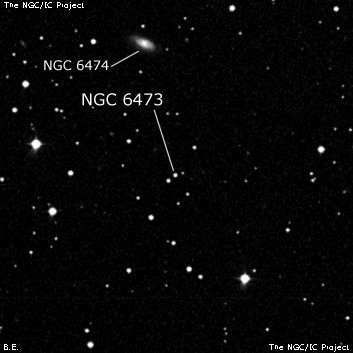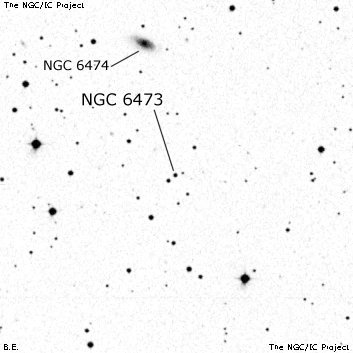NGC/IC Project Restoration Effort
(This is a very very beta version)
NGC6473


Basic Information
Location and Magnitude
Right Ascension: 17:46:54.0
Declination: +57:18:30
Constellation: DRA
Visual Magnitude:
Historic Information
Discoverer: Swift L.
Year of discovery: 1886
Discovery aperture: 16.0
Observational
Summary description: eeF, S, R, s of 2
Sub-type: *
Corwin's Notes
=====
NGC 6473 and NGC 6474 were both found on 22 July 1886 by Lewis Swift.
However, there is only one galaxy close to his position, though he clearly
says he found two (there is a typo in the NGC description for N6474: for
"n of 3", read "n of 2").
Swift's positions are separated by only two seconds of time in RA and 15
arcsec in declination. His description for N6473 (eeF, S, R, s of 2) is not
very helpful, even if it is short enough to have made it into NGC unchanged.
However, his full description for N6474 is more interesting: "eF, pS, R; 3
sts in a line near and 3 others in a line point to it; e diff; n of 2." The
three stars in a line near the galaxy are southeast of it, and the three stars
pointing to it are to the northeast. This pins down NGC 6474 very well.
The only thing close south of the galaxy is an 18th magnitude star that Swift
could not have seen. However, to the northeast, about 30 arcseconds away,
there is a 16th magnitude star that he might have seen. Is this NGC 6473? If
so, Swift got his directions confused. He's done that before, so this star is
a possibility for N6473.
Bigourdan went further south in search of N6473. Four arcmin from Swift's
place, Bigourdan found a triple star which he mistook for a nebula. He called
it N6473 and measured it on two nights. On a third night, he measured another
star which he thought was the same "nebula", but which he found later to be
not just different, but uncatalogued as well. It has ended up with the number
IC 4668 (which see).
In any event, Bigourdan's triple is also a possibility for Swift's nebula. It
would mean a 4 arcmin error in Swift's position, not too much of a stretch.
A further stretch to over 8 arcmin -- much more west than south, though -- is
UGC 10980 = CGCG 300-064. This is just a bit fainter and smaller than N6474,
so could be said to match Swift's description. However, it is far enough away
from his nominal position, and even from the relative position implied by
Swift's published numbers, that I have put it into the position table with
question marks. Still, it is the only galaxy "south" of N6474 anywhere in the
area that Swift could have seen; it would have been about halfway out toward
the edge of his 33-arcmin eyepiece field if N6474 were centered. If he
actually moved the telescope to "measure" its position, UGC 10980 could well
be the object he saw. And the RA may simply be 1 minute of time in error.
Whatever happened, the galaxy certainly deserves a mention here. (My thanks
to Jeff Corder for dragging me back to this field in June of 2009.)



